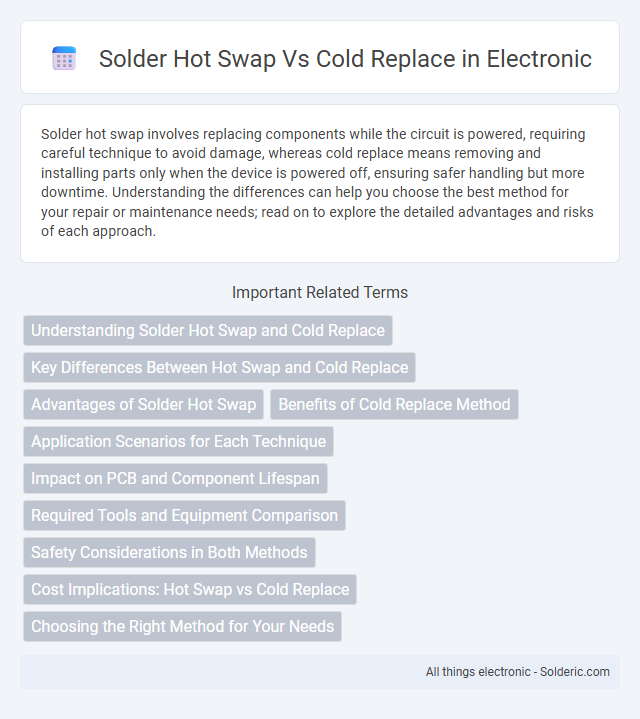Solder hot swap involves replacing components while the circuit is powered, requiring careful technique to avoid damage, whereas cold replace means removing and installing parts only when the device is powered off, ensuring safer handling but more downtime. Understanding the differences can help you choose the best method for your repair or maintenance needs; read on to explore the detailed advantages and risks of each approach.
Comparison Table
| Feature | Solder Hot Swap | Cold Replace |
|---|---|---|
| Definition | Replacing components while the system is powered and soldered in place | Replacing components when the system is powered off and cooled down |
| Power State | System remains powered on during replacement | System is powered off during replacement |
| Risk of Damage | Higher risk due to live electrical currents and heat | Lower risk as no power present and components are cool |
| Required Skill Level | High skill for precise and safe soldering under power | Moderate skill, standard soldering techniques |
| Time Efficiency | Faster fixes without system downtime | Slower due to system shutdown and cooldown time |
| Application | Critical systems needing continuous operation | Non-critical or maintenance windows |
| Equipment Needed | ESD-safe tools, hot air rework station, monitoring devices | Standard soldering station and cooling time |
Understanding Solder Hot Swap and Cold Replace
Solder hot swap involves replacing components or modules while the circuit is energized, requiring careful thermal management and steady-state solder joint integrity to prevent damage. Cold replace occurs when the device is powered off, minimizing the risk of electrical shorts and thermal shock during soldering or desoldering processes. Your choice between solder hot swap and cold replace impacts maintenance safety, equipment uptime, and component reliability in electronic systems.
Key Differences Between Hot Swap and Cold Replace
Hot swap allows the removal and replacement of components without shutting down the system, minimizing downtime and maintaining continuous operation, while cold replace requires powering down the device before swapping parts, ensuring safety and preventing hardware damage. Hot swapping is commonly used in servers and critical systems where availability is paramount, whereas cold replacing is standard in consumer electronics and non-critical environments. Thermal considerations and connector designs differ significantly, with hot swap components built to handle live power conditions, contrasting cold replace parts designed for static, powered-off states.
Advantages of Solder Hot Swap
Solder hot swap provides the significant advantage of maintaining continuous electrical connections during component replacement, minimizing system downtime and preventing data loss in critical applications. This technique enhances thermal and mechanical stability since soldered joints offer superior conductivity and durability compared to cold replace methods. Additionally, solder hot swap reduces the risk of signal interference and contact wear, ensuring consistent performance in high-reliability electronic systems.
Benefits of Cold Replace Method
Cold replace method in soldering minimizes thermal stress on electronic components, preserving their integrity and functionality. This approach reduces the risk of damage caused by excessive heat exposure, enhancing the reliability and lifespan of circuit boards. It also allows for quicker repairs and replacements, improving maintenance efficiency and reducing downtime.
Application Scenarios for Each Technique
Solder hot swap is ideal for applications requiring continuous operation during component replacement, such as in telecommunications and data center hardware where minimizing downtime is critical. Cold replace is suited for devices that can be powered down safely, often found in consumer electronics and automotive systems, where thermal management and safety considerations take precedence. Selecting the appropriate technique depends on system design, operational continuity requirements, and thermal constraints.
Impact on PCB and Component Lifespan
Hot swap soldering allows components to be replaced or inserted while the PCB is powered, reducing thermal cycling and mechanical stress, which helps preserve PCB and component lifespan. Cold replace soldering requires powered-down conditions, increasing thermal cycling and the risk of mechanical damage during insertion, potentially shortening the lifespan of both PCB pads and components. Choosing hot swap methods enhances durability by minimizing thermal shock and mechanical wear on solder joints and PCB traces.
Required Tools and Equipment Comparison
Solder hot swap requires a soldering iron, solder wire, flux, and desoldering tools like a wick or pump to carefully remove and attach components while the device is powered. Cold replace involves powering down the device and using basic hand tools such as screwdrivers, tweezers, and anti-static mats to safely swap components without soldering. Your choice depends on the available equipment and the risk tolerance for thermal or electrical damage during the replacement process.
Safety Considerations in Both Methods
Solder hot swap involves replacing components while the device is powered, which poses significant safety risks such as electrical shock and damage due to short circuits or static discharge. Cold replace, performed with the device powered off, greatly reduces these hazards by eliminating live current during handling, ensuring safer conditions for both the user and the electronic components. Your choice between these methods should prioritize safety protocols, especially wearing anti-static gear and ensuring proper grounding to prevent injury and equipment damage.
Cost Implications: Hot Swap vs Cold Replace
Hot swap technology generally incurs higher upfront costs due to more complex hardware and firmware requirements but significantly reduces downtime, leading to long-term savings in operational expenses. Cold replace systems are typically less expensive initially but can result in increased labor costs and productivity losses due to system shutdowns during maintenance. Evaluating total cost of ownership highlights that hot swap solutions offer better financial efficiency in environments prioritizing continuous operation.
Choosing the Right Method for Your Needs
Choosing between solder hot swap and cold replace depends on your device's sensitivity and downtime requirements. Solder hot swap allows component replacement without powering down, minimizing operational interruptions but needs careful handling to avoid thermal damage. Your choice should balance efficiency with the risk tolerance for potential solder joint degradation.
Solder hot swap vs cold replace Infographic

 solderic.com
solderic.com